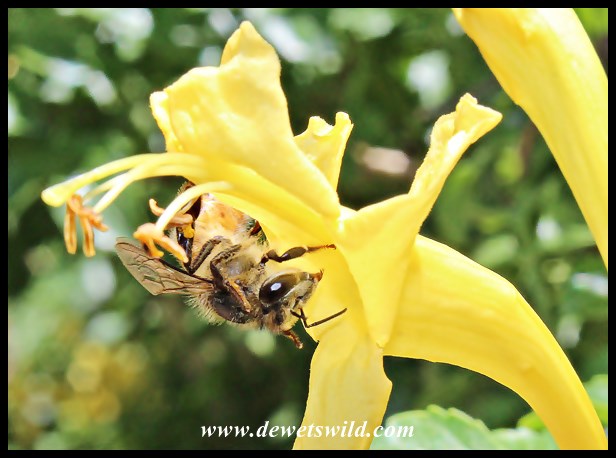Apis mellifera
Two closely related subspecies of Honey Bee are commonly found in South Africa, the Cape Honey Bee from the Western Cape being more aggressive than the African Honey Bee that occurs from the Karoo northwards to Ethiopia and Sudan (distribution map). They were also imported to Brazil from whence they spread all over South and Central America and into the continental United States. African Honey Bees are much more aggressive and tenacious than their counterparts in the Northern Hemisphere, attacking intruders quicker and in greater numbers when defending their hive.
Honey Bees are well-known for being social insects with well-defined castes taking care of various functions within the hive, which is built of wax and resin in natural or man-made cavities. Hives may number up to 50,000 individual bees, with workers living a few weeks and their queen for as long as four years. They feed on both the nectar and pollen of a wide variety of flowering plants.
Honey Bees are vitally important pollinators of indigenous flowering plants as well as cultivated crops. The 20th of May annually has been designated “World Bee Day” to focus attention on declining bee populations and the impact this will have on natural ecosystems and human food production in future.



















Today I learned that there is a World Bee Day. Thanks for the gorgeous pictures and wonderful information about bees.
Welcome here, Geri, and thank you for your kind contribution! Let’s hope that the message of “Bee Day” gets taken to heart by the earth’s population, for all our sakes.
I am fascinated by honey bees… but, I’m allergic!
And, boy oh boy – I can testify that African honey bees are way more potent than European bees! The effects of getting stung by European bees is FAR less sever than being stung by African bees!!
Obviously you’ve had an opportunity to experience both, AJ – thanks for confirming but please stay clear of all bees now!
I’ll try Dries – can’t promise though – I’ve had enough of this cocooning thing already! 😁😁😁
I also love watching honey bees. Of course they are vitally important but for some reason the many other species of bees (and other important pollinators) are often forgotten and they too are vulnerable to a variety of threats. I enjoyed your bee photos.
Thank you, Carol. Indeed, I think we are ignorant about the importance of so many species sharing our world.
Pragtige foto’s Dries. Hier by ons is die bye nogal redelik volop!
Dis wonderlik dat ons nog bye om ons het – blykbaar is dit nie meer oral so nie.
Happy Bee Day from me, too. I spotted some bees today (featured in upcoming posts soon) but they weren’t honey bees. They were some sort of giant bees! I do love to see photos of bees, especially since their situation isn’t good right now. I really like the shot of the swarm.
janet
I’m looking forward to seeing those giant bees you encountered, Janet!
🙂 There’ll be one photo on Friday for sure but I have some amazing video footage as well and not sure when I’ll use that.
Happy Bee Day! I am pleased to see some bees in our garden even though there are not many flowers around to attract them: Cape Honeysuckle and Canary creeper are the mainstays at this time of the year, tiding the bees over until the aloes come out – which some are slowly doing.
I’m also gladdened by the number of bees still buzzing around our little stamp of a garden (where most of these pictures were taken). That wonderful garden of yours must be a haven for the bees!
Great selection of photos – bees are such fascinating creatures
Thank you, Don. I agree that they’re fascinating – such highly evolved behaviour for a “mere” insect – and deserving of more attention.
Great photos, I also completely agree with your comment above about messing with nature and our inability to learn how badly that can go.
Thanks very much, P J B, on both counts!
I’ve seen at least one horror movie about them. Fiction?
Apparently not in the USA, Tracy.
Here in South Africa we do have a few fatalities every year from bee “attacks” – often times utility workers unknowingly opening hives located in power boxes, drains, etc – but not on the kind of scale that will turn the populace into fearing or even hating the bees.
You would want to wear the protective bee gear to do the utility work.
We call them African Killer Bees here in the southeastern U.S.
The hot-blooded Brazilian tinge in their genes not getting any recognition, Deb? 😀
LOL And now we have “murder hornets” on the way from Asia!
The monsters of the world are getting smaller now – bees, hornets and viruses taking over from the boogeyman and Freddy Krueger…
You are so right!
Sometimes experiments go wrong–like the Covid-19 experiment?
These bees were taken to Brazil to experiment by letting them breed among them in order to create a more productive race of bees. The result was the creation of a more aggressive kind of bees, and hard to handle. The natives of several countries call them “killer bees” because they have killed many people with their swarm attacks. Good post, D, 🙂
Messing with nature is seldom a good idea, and that’s a lesson we seem never to learn.